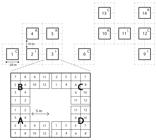The availability of soil nutrients (especially phosphorus) and soil water strongly influence mycorrhizal symbiosis in forest ecosystems. The aim of this study was to evaluate the impact of litter removal and increased soil moisture availability on the spore density and mycorrhizal colonization of apogeotropic and non-apogeotropic roots of a secondary forest stand in eastern Amazonia. We determined the percentage of mycorrhizal colonization of apogeotropic and non-apogeotropic (0-10 cm soil depth) fine roots (diameter ≤ 2 mm), spore density, glomalin concentration, and soil phosphorus availability. Litter removal did not reduce soil phosphorus availability. The spore density was not affected by litter removal. In general, the variables varied on a seasonal basis, except the mycorrizal colonization of non-apogetropic roots and glomalin concentration, but were not affected by irrigation. Mechanical damage to the apogeotropic root system, inherent to the fortnightly litter removal, may have contributed to decrease mycorrhizal colonization of both apogeotropic and non-apogeotropic roots and, consequently, soil glomalin. Our results suggest that the reduction of soil cover may have negative impact over the fungus-plant symbiosis.
glomalin; soil moisture; successional forest

 Soil phosphorus fractions and mycorrhizal symbiosis in response to the
availability of moisture and nutrients at a secondary forest in eastern
Amazonia
Soil phosphorus fractions and mycorrhizal symbiosis in response to the
availability of moisture and nutrients at a secondary forest in eastern
Amazonia Thumbnail
Thumbnail
 Thumbnail
Thumbnail
 Thumbnail
Thumbnail
 Thumbnail
Thumbnail







